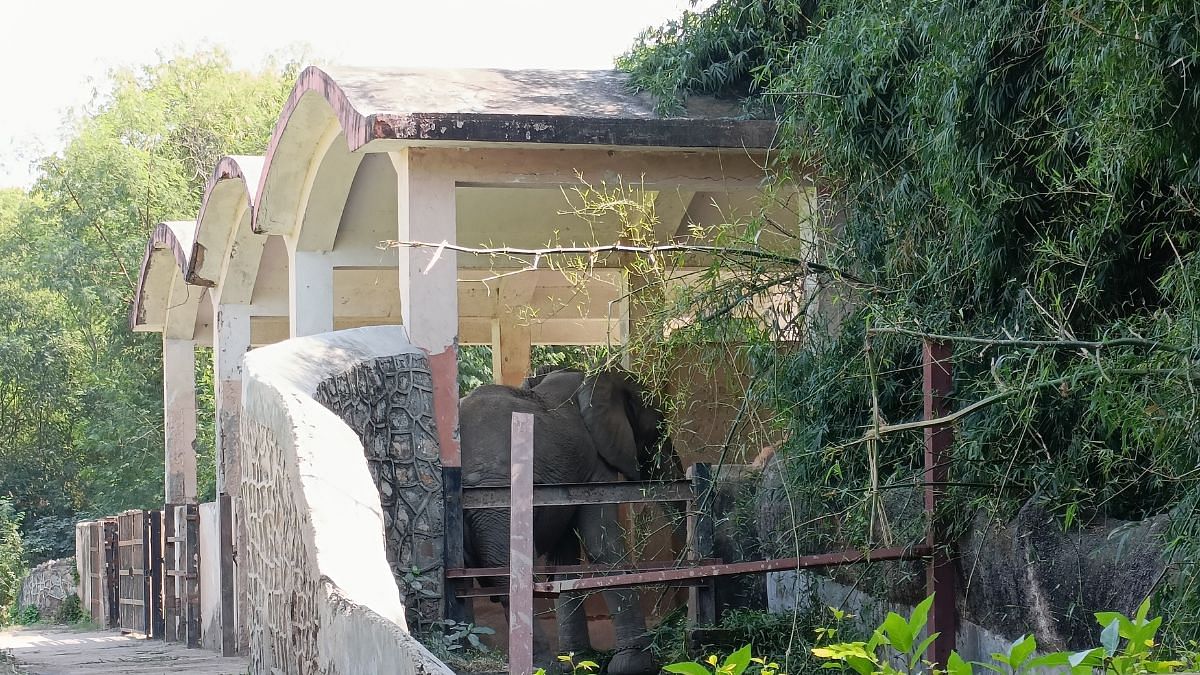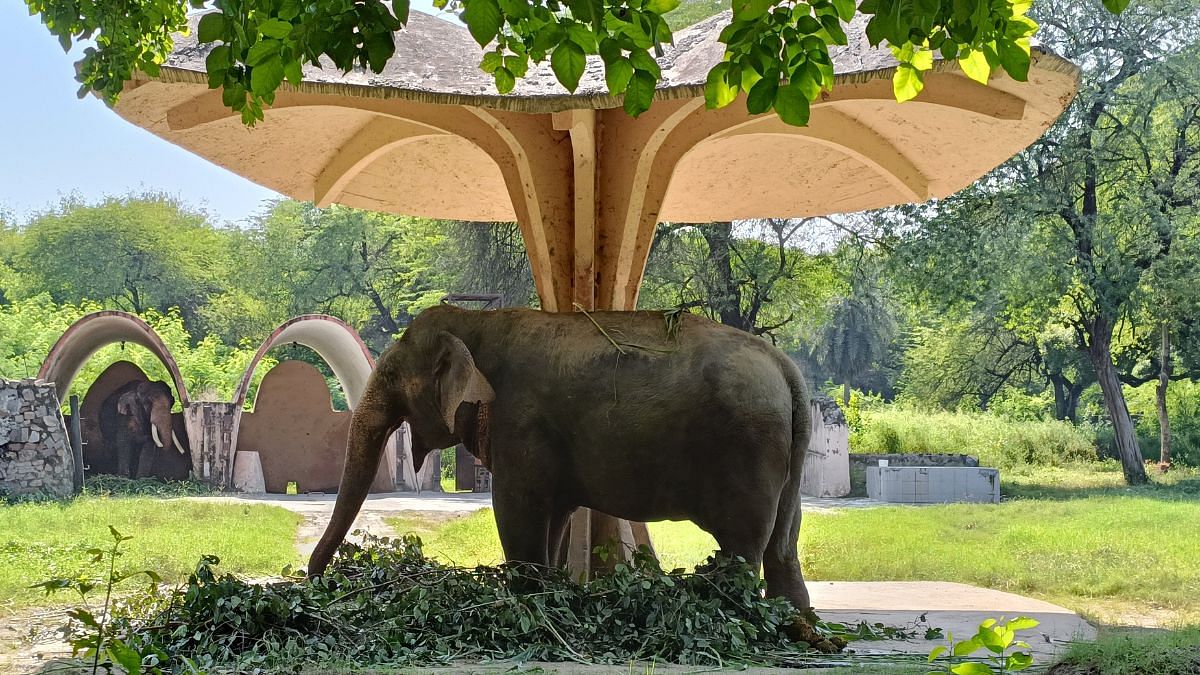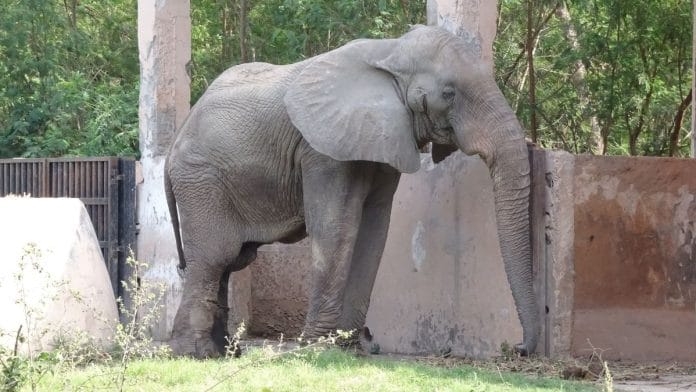New Delhi: Lonely male tusker from Delhi seeking a captive female elephant from Africa, preferably from a zoo. That’s what Shankar’s matrimonial ad would read. The 29-year-old elephant from New Delhi’s National Zoological Park is finally free of his chains. He’s flapping his ears and gorging on cucumbers, according to the Indian government.
Ever since the World Association of Zoo and Aquarium suspended Delhi Zoo’s membership over his mistreatment on 7 October, he has become the centre of attention and concern—national and international.
Animal rights activists are up in arms against his treatment. The Ministry of Environment, Forest and Climate Change is busy posting photos of Shankar gambolling on Delhi Zoo grounds. And now, Zimbabwe and Botswana have volunteered to each send him one female companion so that he won’t be lonely.
Shankar–who according to his mahouts can be quite stubborn—is oblivious to the attention and brouhaha he has generated. On 10 October, he chose to turn his back to the hundreds of people who had gathered around his enclosure to chomp on sugarcane. “He loves bananas,” said a Delhi Zoo official. But at the time, his two front legs were still in chains.
His mental health has become a matter of national interest. A team of veterinarians from Reliance’s Greens Zoological Park and Rehabilitation Centre (Vantara) recently visited the tusker to assess his health and well-being.
“Shankar needs to be around others of his kind for his psychological well-being,” said Shubhobroto Ghosh, wildlife projects manager at World Animal Protection in India. When the elephant’s condition became public knowledge, zoo officials said that it was because he was in musth. But according to Ghosh, his bouts of aggressive behaviour can’t just be attributed to this.

“The deeper reason is that he is lonely, and he is acting out. He needs companionship. And that needs to happen immediately,” Ghosh added.
It’s not that we haven’t been trying, said zoo officials who are reluctant to talk about the elephant, and set off another national crisis. His well-being is now the top priority.
“Shankar’s childhood was spent with Mohini and Bholi, the two Asian female elephants. But they had to be separated in 2009 when the CZA (Central Zoo Authority) ordered that elephants should not be displayed in zoos,” said Delhi Zoo director Sanjeet Kumar, who was posted here in February. “Mohini and Bholi were then sent to Jim Corbett.” But Shankar remained behind alone because he was a diplomatic gift from Zimbabwe.
A mate for Shankar
Shankar, who is now approximately 4,000 kg according to Delhi Zoo authorities, was a mere 450 kg when he stepped foot on Indian soil for the first time in 1998. He and his female companion Bombai were gifts from then President of Zimbabwe Robert Mugabe to the then President of India Shankar Dayal Sharma. The elephant is named after the president.
While the exact origins and birth dates of the elephants are unknown, Delhi Zoo officials said that the two were born in the wild sometime during November 1996, and were found soon after.

But for the past eight years, he has been mired in controversy.
The six-month suspension of Delhi Zoo’s membership by the World Association of Zoos and Aquariums is one in a series of actions from concerned citizens and activists. They couldn’t see this elephant alone, without a mate and tied up in chains.
Since 2012, he has been living in a separate enclosure from the other Indian elephants in the zoo, and all efforts to find him a suitable mate within or outside India have been unsuccessful. More pressingly, even the CZA objected to seeing Shankar in chains, reminding Delhi Zoo about how it was not good for the elephant’s well-being and completely against the upkeep guidelines for Indian zoological parks.
In 2021, PTI reported that due to being chained for so long, Shankar had developed wounds on his legs and had to be sedated for treatment. While the Delhi Zoo itself has been trying to secure a mate for Shankar for almost a decade now, teenager Nikita Dhawan from the Delhi-based YouthforAnimals petitioned the High Court to look into his condition in 2022. The petition noted that Shankar, who spent a large amount of time alone and in chains, exhibited ‘stereotypic behaviour’ and was under stress.
The High Court, too, ordered the Delhi Zoo to take action against Shankar’s mistreatment and find him a mate.

“We always knew that Shankar needed a mate sooner or later, and we started preparations the minute he turned mature. However, there are regulatory hurdles you just cannot overcome,” said Dr Paneer Selvam, a former veterinarian at the Delhi Zoo, who knew Shankar when he was a calf.
Senior zoo officials explained how they reached out to multiple foreign zoological parks to find a suitable mate for the tusker. Their criteria: She needs to be a female, African, captive elephant that another zoo was willing to let go of.
Hurdles arose everywhere – the European Association of Zoos and Aquariums said they did not have any surplus African females. While in the last five years the Delhi Zoo came close to acquiring a mate from South Africa and Dubai, it never panned out successfully.
“Even in India, Vantara has acquired some African elephants but their status is not the same as Shankar. They are rescued from circuses and other places, have not lived in zoos, and might not be compatible with Shankar — the priority isn’t to just find any mate but a compatible mate,” said a senior forest official under anonymity.
Now, after the WAZA suspension on 7 October, the Delhi Zoo finally seems close to finishing its 20-year-long search for Shankar’s partner. Botswana and Zimbabwe have both come forward to offer a companion for the lonely African tusker.
Also read:
Arrival and adoption
Bombai died within two years of coming to India, recalled a senior official at the Delhi Zoo. The female elephant, then still a calf, died in front of his eyes because of a condition called impaction colic.
“The diet and environment changes in India were not suitable to her,” he added. After her death, zoo officials were more than just sad – they became extra cautious about Shankar and his diet.
“We were worried about this calf, barely four years old, stranded in a strange land – who would he mingle with? We made sure he was comfortable and that being alone would not impact him psychologically,” said Selvam.
That was when the zoo authorities decided that they would raise him alongside the other Asian elephants in the zoo. Shankar joined the tiny herd of Asian elephants and was adopted by Rajalakshmi, one of the grown matriarch elephants who began to care for Shankar like a mother.
The first few years of Shankar’s life were thus spent with his adopted mother Rajalakshmi, and his companions Mohini and Bhoti as part of the Asian elephant herd. Word around the zoo was that these three elephants were the three ‘mothers’ of Shankar and they brought him up.
“It is necessary for all elephants to mingle, and grow up in a herd. Bombai passed early but we always wanted Shankar to experience socialising with other elephants, and those early years with Rajalakshmi were good for him,” said a senior official at the Delhi Zoo.
However, very soon the inevitable happened. Shankar started growing up and showing signs of maturity. When he experienced his first musth – the period of aggressive behaviour in male elephants due to heightened reproductive hormones – around 2012, the zookeepers understood they had to soon start separating Shankar from the Asian herd. He got into a couple of fights with a male Asian elephant before they decided to keep him in his own enclosure.
Delhi Zoo officials were initially not worried about a mate for Shankar. At the time, Mysuru Zoo was home to three African elephants – a male, a female and their child Rambo. They figured that the male and female would mate again, and there would be hope for a mate for Shankar in the coming years. However, both the parents of Rambo died before 2016. India was just left with two young male African elephants with no mate in sight.
Also read:
Musth and mate – two problems
Under Project Elephant and the Wildlife Protection Act, of 1972, the Indian government has very strict laws on the capture, housing, and care of elephants.
Keeping elephants chained for too long, keeping them in solitary confinement in zoos, or even capturing wild elephants and displaying them in zoos are all discouraged by the government. But Delhi Zoo officials say that Shankar’s musth necessitates solitary confinement. In that state, he can harm animals and even people.
“Being in musth means an elephant is healthy – he is exhibiting all normal signs of a male elephant his age,” said a retired official from the zoo, who does not wish to be named. “And this practice of tying up musth elephants is practised everywhere, be it Asian or African elephants,” he added.
Ghosh, who is the author of the Indian Zoo Inquiry, first came across Shankar’s case in 2004 and recommended that he be socialised with the other African elephants in Mysuru Zoo. Activists such as Nikita Dhawan, the teenager who petitioned the High Court for Shankar’s well-being, still argue that releasing him into the wild is the best solution. But because Shankar is a diplomatic gift, the rules are a little different.
He is ‘exotic’—not native to India—and cannot be released into the wild here like other Asian elephants. Moreover, in 2022, the Delhi High Court ruled that Shankar is “our property” and will not be sent to Africa or anywhere else to be released into the wild. According to Ghosh, this makes any plans of Shankar’s rewilding “legally impossible.”
Meanwhile, Shankar continues to get even lonelier. In the video that the MoEFCC released on 10 October, he can be seen weaving his head from side to side.
“The bobbing of his head is stereotypic behaviour—a classic sign of loneliness,” said Ghosh.
(Edited by Zoya Bhatti)






